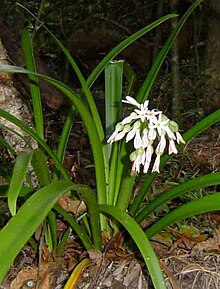Cliviinae
 From Wikipedia the free encyclopedia
From Wikipedia the free encyclopedia
| Cliviinae | |
|---|---|
 | |
| Clivia nobilis | |
| Scientific classification | |
| Kingdom: | Plantae |
| Clade: | Tracheophytes |
| Clade: | Angiosperms |
| Clade: | Monocots |
| Order: | Asparagales |
| Family: | Amaryllidaceae |
| Subfamily: | Amaryllidoideae |
| Tribe: | Haemantheae |
| Subtribe: | Cliviinae D. & U. M.-D.[1] |
| Type genus | |
| Clivia | |
| Genera | |
| Synonyms | |
| Clivieae Traub | |
Cliviinae is a small subtribe of Haemantheae, and therefore within the African clades of Amaryllidoideae. It consists of two genera, Clivia, and Cryptostephanus.
Description[edit]

Bulbless rhizomatous perennial plants. Clivia has showy orange or yellow flowers, while Cryptostephanus has smaller flowers with a paraperigone that had them erroneously classified with Narcissus in the past. it is also the only Haemantheae genus with a phytomelanous seed testa.[1]
Taxonomy[edit]
For the early taxonomic history of these two genera, see Meerow and Clayton (2004).[1] (Traub described this grouping as tribe Clivieae in his 1963 monograph on the Amaryllidaceae, based on the type genus Clivia. .[2] Subsequently, the Müller-Doblies' reduced it to a subtribe and placed it within the Haemantheae.[3] Later molecular phylogenetic research has confirmed this placement, with Cliviinae being one of three subtribes of Haemantheae.[1]
Phylogeny[edit]
The Cliviinae are placed within the Haemantheae as follows:
| Tribe Haemantheae |
| ||||||||||||
Subdivision[edit]
- Clivia (5 species)
- Cryptostephanus (2 species)
Distribution and habitat[edit]
Clivia is found in summer rainfall regions, as herbaceous understory plants of coastal and Afro-montane forest, while Cryptostephanus are plants of savanna or forest habitats.[1]
Ecology[edit]
Butterfly and sunbird pollination.[1]
References[edit]
Bibliography[edit]
- Meerow, Alan W.; Clayton, Jason R. (1 February 2004). "Generic relationships among the baccate-fruited Amaryllidaceae (tribe Haemantheae) inferred from plastid and nuclear non-coding DNA sequences". Plant Systematics and Evolution. 244 (3–4): 141–155. doi:10.1007/s00606-003-0085-z. S2CID 10245220.[permanent dead link]
- Meerow, Alan W.; Snijman, Deirdre A. (2006). "The never-ending story: multigene approaches to the phylogeny of Amaryllidaceae". Aliso. 22: 355–366. doi:10.5642/aliso.20062201.29. Retrieved 25 January 2015.
- Vigneron, Pascal. "Amaryllidaceae". Amaryllidaceae.org (in French). Archived from the original on 4 January 2015. Retrieved 23 October 2014.
- "Amaryllidaceae: A taxonomic tool for the Amaryllidaceae of the world". eMonocot. Archived from the original on 2016-03-04. Retrieved 2016-03-06.
- Traub, H.P. (1963). Genera of the Amaryllidaceae. Genera of organisms. La Jolla, California: American Plant Life Society.
- Müller-Doblies, U.; Müller-Doblies, D. (1996). "Tribes and subtribes and some species combinations in Amaryllidaceae J St Hil R Dahlgren & al. 1985". Feddes Repertorium. 107 (5–6): S.c.1–S.c.9.
- Spies, P.; Grobler, J.P.; Spies, J.J. (2011). "A review of phylogenetic relationships in the genus Clivia". Philos. Trans. Genet. 1: 168–207.
- Conrad, Ferozah (February 2008). Molecular Systematics, Biogeography and Dating of the tribe Haemantheae (Amaryllidaceae) and the Phylogeography of Clivia (PhD Thesis). Department of Botany, University of Cape Town.
- Spies, Paula (December 2013). A comparison of the efficiency of DNA barcoding regions in a small and a large genus (PhD Thesis). Department of Genetics, University of the Free State.